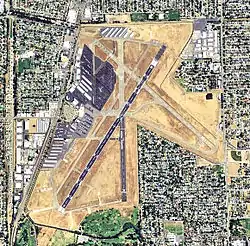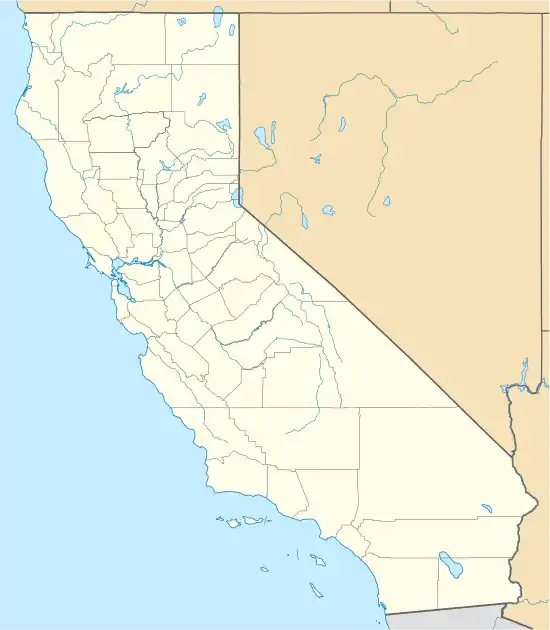Sacramento Executive Airport
Sacramento Executive Airport (IATA: SAC, ICAO: KSAC, FAA LID: SAC) is a public airport three miles (5 km) south of downtown Sacramento, in Sacramento County, California. The airport covers 540 acres (219 ha) and has three runways (two lit) and a helipad.
Sacramento Executive Airport | |||||||||||||||||||
|---|---|---|---|---|---|---|---|---|---|---|---|---|---|---|---|---|---|---|---|
 2006 USGS photo | |||||||||||||||||||
| Summary | |||||||||||||||||||
| Airport type | Public | ||||||||||||||||||
| Operator | Sacramento County | ||||||||||||||||||
| Location | Sacramento, California | ||||||||||||||||||
| Elevation AMSL | 24 ft / 7 m | ||||||||||||||||||
| Coordinates | 38°30′45″N 121°29′36″W | ||||||||||||||||||
| Map | |||||||||||||||||||
 KSAC | |||||||||||||||||||
| Runways | |||||||||||||||||||
| |||||||||||||||||||
| Helipads | |||||||||||||||||||
| |||||||||||||||||||

History
When it opened in 1930 Executive Airport was known as Sutterville Aerodrome. As the city-owned facility expanded, in 1941 construction was under way to pave and extend the airport's three runways.[1]
The U.S. Army Air Corps took over the airport during World War II; after the war, control returned to the city and the facility was renamed Sutterville Auxilary Field. The airfield was used by 4th Air Force and the Army Air Forces Western Flying Training Command. Training was first on Bell P-39 Airacobra, as Chico Army Airfield auxiliary field. On April 7, 1945, training switched to heavy bomber with the 404th and 405th Army Air Force. The US made many improvements to the airfield. After the war the Sacramento Army Air Field returned to its owner, the City of Sacramento, and was renamed Sacramento Municipal Airport.
In the late 1940s and early 1950s more improvements were made to parking and taxiway paving, water and sewer systems, and runway/taxiway lighting. The terminal building was built in 1955 along with some navigational aids and T-hangars.</ref>In October 1967 most airlines moved to the new Sacramento International Airport and the Sacramento Municipal Airport was renamed Sacramento Executive Airport.[2][3]
A United DC-3 started flying nonstop to Los Angeles in 1946, but nonstops from SAC never reached north beyond Medford or east beyond Nevada. Jets (United 727s and Western 720Bs) appeared in 1964.
In the airport's last summer of airline operations, the August 1967 Official Airline Guide lists 22 weekday nonstops to San Francisco, 11 to Los Angeles, seven to Reno, two to Medford, two to Marysville, and one each to Lake Tahoe, Klamath Falls and Oakland. Pacific Air Lines flights to the north continued to Chico, Eureka/Arcata, Crescent City and Portland. Pacific Air Lines flight 771 (a Fairchild F-27) flew Reno-Lake Tahoe-Sacramento-San Francisco-San Jose-Fresno-Bakersfield-Burbank-Los Angeles-San Diego. United Airlines flight 224 was a Boeing 727-100 San Francisco-Sacramento-Reno-Denver-Chicago-New York La Guardia. Aircraft included Martin 4-0-4s and Fairchild F-27s (on Pacific Air Lines), Lockheed L-188 Electras (on Pacific Southwest Airlines (PSA) and Western Airlines), Boeing 727-100s (on PSA and United Airlines) and Boeing 720Bs (on Western); Western had one B720B nonstop a day to LAX.
In October 1967 the airlines moved to the new Sacramento Metropolitan Airport (SMF) and Sacramento Municipal Airport was renamed Sacramento Executive Airport. The County of Sacramento became the operator of both airports.
Executive Airport is self-supporting, receiving no city, county, or tax money. All operating expenses are paid by users.
1972 Farrell's Ice Cream Parlour Crash
On September 24, 1972 a former military Canadair Sabre Mk. 5 jet in civil ownership with US registration N275X was set to perform an air display at the Golden West Sport Aviation Show. Due to pilot error, the airplane failed to become airborne, went off the end of the runway, across a road and crashed into Farrell's Ice Cream Parlour. The explosion killed 22, twelve of those children, and injured 28 more people. The tragedy prompted closure of that runway, stricter regulations at the airport, and the opening of the Sacramento Firefighter's Burn Institute.[4] The Crossroads shopping center that housed the ice cream parlour was closed and rebuilt in 2002 as the Sacramento Public Safety Center, which is the main center for the Sacramento Fire Department and Sacramento Police Department.[5]
A memorial was built at the crash site and dedicated in March 2003.[5]
Facilities
In addition to an FAA tower, the airport has three paved runways (two lighted) and has tie-downs and hangar rentals. In 2004, aircraft operations averaged 370 per day.[6]
Over 20 businesses are located at Executive: air charters; aircraft sales, rentals and repairs; flight training; pilot supplies; computer-based testing; and car rentals.
10 minutes from downtown Sacramento, Executive is close to tourist attractions such as Old Sacramento, the State Capitol, Cal Expo State Fairgrounds, and Golden 1 Center (new arena of the Sacramento Kings). The airport is near three public golf courses and major shopping areas.
Executive has two lighted runways: Runway 2/20 is 5,503 ft x 150 ft. (It was 6000 feet when the airlines were there.) Runway 2 has a Medium Intensity Approach Light System with Runway Alignment Indicator Lights (MALSR), while REIL and PAPI are on Runway 20 and Runway 12/30. Runway 16/34 was closed in September 2017 and marked permanently closed as of February 13, 2019.[7] The FAA contract control tower operates 06:00–21:00 (local).
Fuel is available from trucks or 24-hour self-serve credit card pumps, and plenty of tie-down and transient parking is available, the first six hours being free. Automobile parking in front of the terminal is plentiful, and free for the first 72 hours.
Amenities include:[8]
- Pilot's lounge
- SACjet terminal with available meeting rooms
- Executive Airport terminal with available meeting rooms
- Disabled access, accommodations, and services throughout the facilities
- Restaurant in the terminal building
- Self-serve 100 LL Avgas, Jet A, tie-downs, hangar space, FBO and line services
- Contract control tower 6 a.m. to 9 p.m. daily (Serco)
- Free, short-term (72-hour) auto parking
Restaurants
Serving breakfast, lunch, and dinner, Aviators overlooks the airfield and can hold up to 190 people. It is available for banquet use and other events.
Cargo carriers
| Airlines | Destinations |
|---|---|
| Ameriflight | Oakland, Portland, Reno |
References
- calisphere.org, Sutterville Aerodrome
- sacramento.aero, Sacramento International Airport History", September 27, 2011
- Sacramento Chronicles: A Golden Past, By Cheryl Anne Stapp
- "The Crash at Farrell's Ice Cream Parlor in Sacramento, CA – September 24, 1972". Check Six. 2002. Retrieved December 13, 2006.
- Pierleoni, Alan (September 24, 2012). "Somber event recalls Farrell's jet-crash disaster". Sacramento Bee. Archived from the original on January 12, 2014. Retrieved February 8, 2014.
- AirNav info for Sac Executive
- "Federal Aviation Administration: NOTAM Search". Retrieved 2019-04-23.
- About Executive Airport
![]() This article incorporates public domain material from the Air Force Historical Research Agency website http://www.afhra.af.mil/.
This article incorporates public domain material from the Air Force Historical Research Agency website http://www.afhra.af.mil/.
External links
- Executive Airport (SAC) (official Sacramento County Airport System site)
- FAA Airport Form 5010 for SAC PDF
- FAA Airport Diagram (PDF), effective January 28, 2021
- Resources for this airport:
- AirNav airport information for KSAC
- ASN accident history for SAC
- FlightAware airport information and live flight tracker
- NOAA/NWS weather observations: current, past three days
- SkyVector aeronautical chart for KSAC
- FAA current SAC delay information
.svg.png.webp)